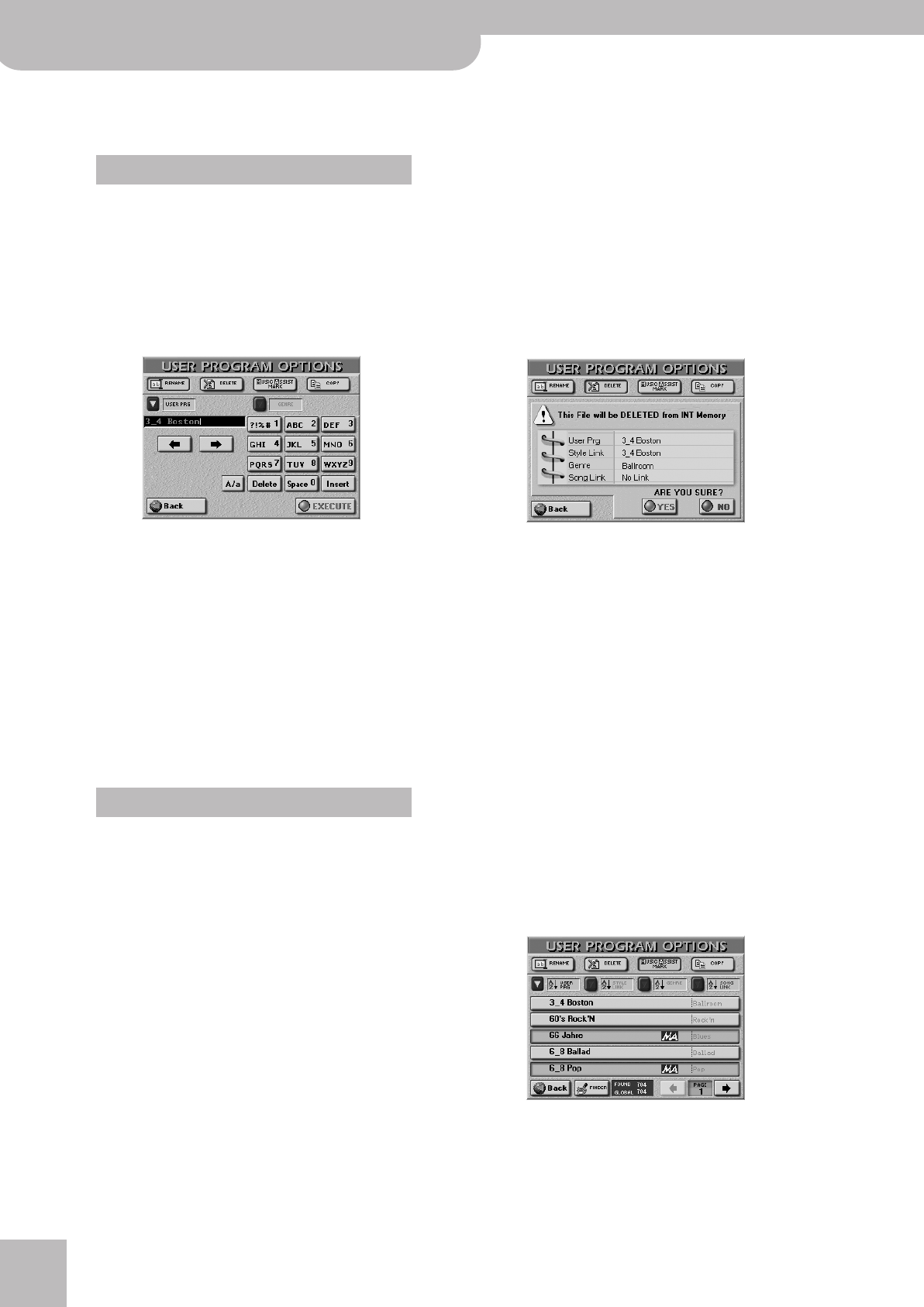
Working with User Programs
96
r
E-60/E-50 Music Workstation
Editing the User Program Finder information
The Finder information is based on search criteria that
need to be added to User Program files.
The [OPTIONS] field in the lower left corner provides
access to a display page where you can add database
information. This also works for User Program files
that already contain entries you wish to modify.
(1) First select the User Program whose database
information you wish to change or edit by pressing
its field.
(2) Press the [OPTIONS] field.
(3) Now do one of the following:
■Rename
This function allows you to change (or supply) the
USER PRG and GENRE information of the selected
User Program. (STYLE LINK and SONG LINK cannot be
edited in this way. See page 94 for how to do that.)
Note: In the case of a floppy disk, you can only change the
“USER PRG” entry.
• Press the [USER¥PRG] or [GENRE] field and enter the
desired characters.
• The [A/a] field allows you to switch between upper-
case and lowercase characters.
Before performing the next step, we’d like to inform
you about the possible consequences of renaming a
User Program (USER PRG). From the illustration on
page 88, you may remember that each User Program
is, in fact, a separate file.
You can bundle 144 such files into a User Program
Set List whose “members” can be recalled via the dis-
play (or using the USER PROGRAM [DOWN]/[UP] but-
tons on the front panel). When you select a memory
[1]~[8] on pages P1~18, the E-60/E-50 therefore
loads the settings of the file in question. So here’s
what may happen:
• Press the [EXECUTE] field.
■Delete
This function allows you to delete the selected User
Program from the internal memory area or memory
card. You should use this as sparsely as possible.
• Press the [DELETE] field. Deleting a User Program can-
not be undone, which is why the following question
is now displayed:
[YES] deletes the User Program file.
[NO] leaves the file intact and takes you back to the
initial User Program Finder page with the list.
[Back] leaves the file intact and takes you back to the
USER PROGRAM LIST page.
Note: If a User Program you delete here is assigned to a Set
List, the memory in question no longer works.
Note: Deleting a User Program that doubles as Music Assistant
registration also discards the Music Assistant entry. For safety
reasons, an error message is displayed in that case.
■Music Assistant Mark
Note: This function is not available for User Programs that
reside on floppy disk or on a memory card.
This option allows you to add an “MA” label to the
selected User Program, which means that its registra-
tion settings appear in the Music Assistant list (see
p. 33).
• If necessary, copy the User Program to the internal
memory.
• Press the [MUSIC¥ASSIST¥MARK] field.
Use the familiar Finder functions to locate the User
Programs you want to appear in the Music Assistant
list, then press their fields to add (and again to
remove) the “MA” label.
User Program Options
What happens when you execute?
• If you rename a User Program that is referenced by the
currently active Set List, the Set List is updated (and
therefore finds the User Program despite its new name).
• If you rename a User Program that is referenced by
other Set Lists (which you didn’t load), those lists no
longer find the User Program you renamed. Conse-
quently, when you select the memory in question (after
loading the Set List), nothing happens, because that ref-
erence no longer works.
• Renaming a User Program that doubles as Music Assis-
tant entry (and therefore has a “MA” label, see below)
also affects the Music Assistant registration’s name
(which changes accordingly).
E-60_50_OM_UK.book Page 96 Thursday, June 22, 2006 10:06 AM


















